France's wildest festival gets underway amid tight security

One of France's most famous festivals kicked off on Wednesday and promises to be as wild and raucous as ever, despite the tight security. We take a closer look at the Fêtes de Bayonne.
What's red and white and runs for five days?
The Bayonne Festival of course - better known in French as the Fêtes de Bayonne. And it begins on Wednesday July 27th.
Around one million revellers will put aside their fears over terror attacks and put on something red and white to attend France's wildest festival. However many object to the bullfighting aspect of the festivities.
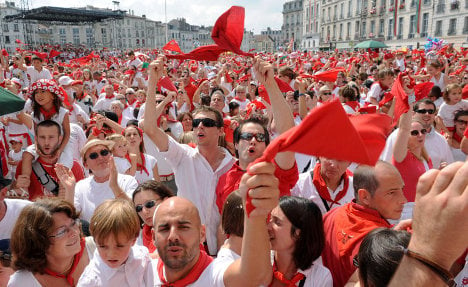 So what exactly is it?
The Fêtes de Bayonne is a five-day festival in south western France that is known for being a blur of parades, dancing, and good food.
Andy Fisher, a guide from the local tourist office, says the event is quickly becoming "one of the biggest festivals on the planet".
"There's everything you could want in a festival and a huge variety of activities. It's a real excuse for a good knees-up for all generations," the New Zealander told The Local.
The event, which runs until July 31st, typically draws up to a million people - all encouraged to wear white clothes together with red scarves, sashes, and hats.
So what exactly is it?
The Fêtes de Bayonne is a five-day festival in south western France that is known for being a blur of parades, dancing, and good food.
Andy Fisher, a guide from the local tourist office, says the event is quickly becoming "one of the biggest festivals on the planet".
"There's everything you could want in a festival and a huge variety of activities. It's a real excuse for a good knees-up for all generations," the New Zealander told The Local.
The event, which runs until July 31st, typically draws up to a million people - all encouraged to wear white clothes together with red scarves, sashes, and hats.
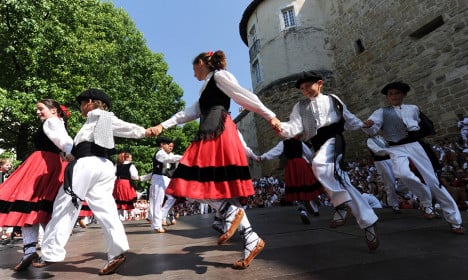
(Children dance at the 2014 Fêtes de Bayonne. Photo: AFP)
Will it be the same Bayonne festival as usual or have terror fears impacted it?
There's no doubt terror fears will be on the minds of the organisers and French authorities if not the revellers themselves. But everyone was keen for it to go ahead and once the decision was made not to cancel it, everyone will be determined to make it a success.
"We have taken into account the increased threat, but we have no evidence at this stage that we should cancel the festival," local police chief Pierre-André Durand said recently.
He added that cancelling it would be "giving in to terrorists", reported France Bleu.
However there will be some changes. For a start 1,900 forces of law and order will be on duty, although that's reportedly only 100 more than usual.
The special day for children the Journée des enfants, when a huge picnic takes place at midday, featuring games and clowns, has however been cancelled and the opening cermeony on Wednesday night has been scaled down.
However the annual omelette competition will go ahead as planned.
So what can we expect?
Each day will be jam packed with activities including parades of illuminated floats, traditional songs and dances, food and drink stalls in every direction, music concerts, and bull running.
At nights, festival goers are known to dance, spin, and often stumble from peñas to peñas (neighbourhood clubs) in a sea of sound and movement that lasts until the early hours of the morning.
The opening party on Wednesday night always is a hit (see video above), as is the closing party which promises an enormous fireworks show.
There are plenty of traditions on hand too, one that sees King Leon, a huge papier mache figure, watching over other huge inflatable giants that are paraded through the streets.
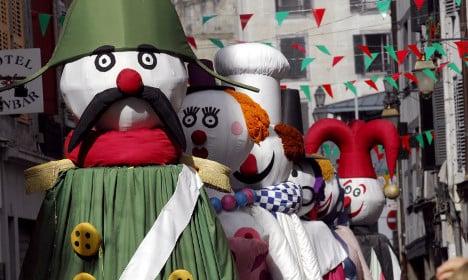
(The giants of the Fêtes de Bayonne. Photo: AFP)
These represent the king's court - including the jester, the marshall, the chocolatier, the housekeeper and the doctor (see above). They are all said to represent values expected from the crowd during the festival, like fun, good health, and good behaviour.
At the opening ceremony, King Leon gives the key to the city to a celebrity to open the festival. In the past, these have included actor Vincent Cassel, tennis ace Yannick Noah, singer Johnny Hallyday, and Spanish tenor Luis Mariano, who even composed a song about Bayonne.
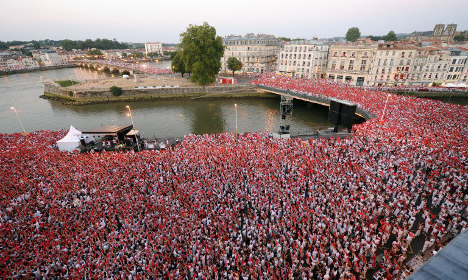 (The opening of the 2014 Fêtes de Bayonne. Photo: AFP)
Hang on, why red and white? Aren't Bayonne's colours blue and white?
The festival initially featured blue and white outfits, and some of the traditionalists still show up wearing these colours. Indeed, the local football club Aviron Bayonnais wears blue.
The overwhelming majority of festival goers nowadays, however, wear red and white, creating magnificent pictures like the one below.
The event is actually inspired by the San Fermin festival across the Spanish border in Pamplona where revellers also don the Basque red and white. The festival was founded in Bayonne in 1932 by some local rugby lads who had recently returned from the running of the bulls and wanted to enjoy the same festivities at home.
(The opening of the 2014 Fêtes de Bayonne. Photo: AFP)
Hang on, why red and white? Aren't Bayonne's colours blue and white?
The festival initially featured blue and white outfits, and some of the traditionalists still show up wearing these colours. Indeed, the local football club Aviron Bayonnais wears blue.
The overwhelming majority of festival goers nowadays, however, wear red and white, creating magnificent pictures like the one below.
The event is actually inspired by the San Fermin festival across the Spanish border in Pamplona where revellers also don the Basque red and white. The festival was founded in Bayonne in 1932 by some local rugby lads who had recently returned from the running of the bulls and wanted to enjoy the same festivities at home.
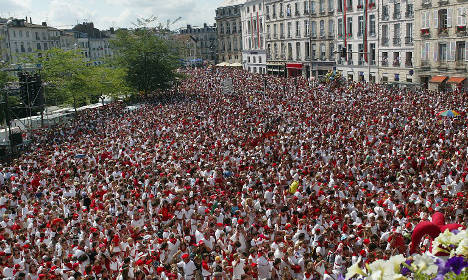
(Red and white as far as the eye can see in Bayonne. Photo: AFP)
What about all this bull running?
The ever-divisive "bull running" is a main draw card of the festival - it was inspired by Pamplona, after all, although it's not quite like the famous bull running of San Fermin.
In Bayonne the bulls are actually cows with horns, and they don't run through town but are released on the crowd in front of the Château Neuf, and they still hurt if they run you down as the man in the video below found out, while he was trying to take a selfie.
Bullfighting will take place on Saturday and Sunday. While many object the local tourism board notes that "Bayonne is proud of this tradition".
Bayonne is the oldest bull-fighting town in France, and boasts the world's oldest written text on the subject dating back to 1289.
But the bullfighting is also the reason why many refuse to contemplate the idea of going to the festival, as The Local found out on our Facebook page.
"Because there is bullfighting and terrified animals running around I will never go to this. Bullfighting should banned," said one reader.
"The Fete is completely centred around bullfighting and bull running. Shame on anyone who thinks this is acceptable behaviour," said another.
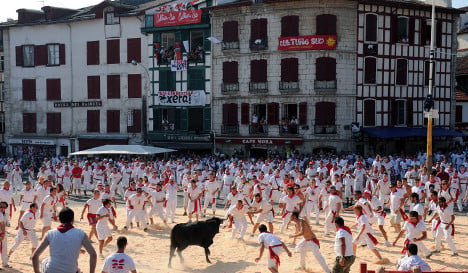
(The "bull running" at a previous Fêtes de Bayonne. Photo: AFP)
Getting there
So, you're keen to join the festivities? Here's how to get there. The town is located to the east of Biarritz in south-western France, not far from the Spanish border.
It's served by the Biarritz-Anglet-Bayonne Airport which operates daily flights within France and abroad.
If you're taking the train, Bayonne has a TGV station. Motorists can access the town from highways D 810, RN 117, A63, and A64.
Bayonne's official tourism site has extensive information in English, including an extensive guide to getting there.
This article has been altered from when it was first published to reflect that many are opposed to the bullfighting aspect of the festival. We regret giving the impression that we would promote this part of the festival.
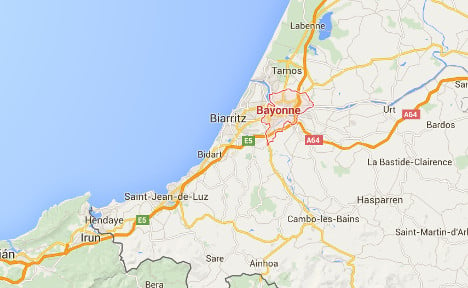
(Photo: GoogleMaps)
Comments
See Also
What's red and white and runs for five days?
The Bayonne Festival of course - better known in French as the Fêtes de Bayonne. And it begins on Wednesday July 27th.
Around one million revellers will put aside their fears over terror attacks and put on something red and white to attend France's wildest festival. However many object to the bullfighting aspect of the festivities.

So what exactly is it?
The Fêtes de Bayonne is a five-day festival in south western France that is known for being a blur of parades, dancing, and good food.
Andy Fisher, a guide from the local tourist office, says the event is quickly becoming "one of the biggest festivals on the planet".
"There's everything you could want in a festival and a huge variety of activities. It's a real excuse for a good knees-up for all generations," the New Zealander told The Local.
The event, which runs until July 31st, typically draws up to a million people - all encouraged to wear white clothes together with red scarves, sashes, and hats.

(Children dance at the 2014 Fêtes de Bayonne. Photo: AFP)
Will it be the same Bayonne festival as usual or have terror fears impacted it?
There's no doubt terror fears will be on the minds of the organisers and French authorities if not the revellers themselves. But everyone was keen for it to go ahead and once the decision was made not to cancel it, everyone will be determined to make it a success.
"We have taken into account the increased threat, but we have no evidence at this stage that we should cancel the festival," local police chief Pierre-André Durand said recently.
He added that cancelling it would be "giving in to terrorists", reported France Bleu.
However there will be some changes. For a start 1,900 forces of law and order will be on duty, although that's reportedly only 100 more than usual.
The special day for children the Journée des enfants, when a huge picnic takes place at midday, featuring games and clowns, has however been cancelled and the opening cermeony on Wednesday night has been scaled down.
However the annual omelette competition will go ahead as planned.
So what can we expect?
Each day will be jam packed with activities including parades of illuminated floats, traditional songs and dances, food and drink stalls in every direction, music concerts, and bull running.
At nights, festival goers are known to dance, spin, and often stumble from peñas to peñas (neighbourhood clubs) in a sea of sound and movement that lasts until the early hours of the morning.
The opening party on Wednesday night always is a hit (see video above), as is the closing party which promises an enormous fireworks show.
There are plenty of traditions on hand too, one that sees King Leon, a huge papier mache figure, watching over other huge inflatable giants that are paraded through the streets.

(The giants of the Fêtes de Bayonne. Photo: AFP)
These represent the king's court - including the jester, the marshall, the chocolatier, the housekeeper and the doctor (see above). They are all said to represent values expected from the crowd during the festival, like fun, good health, and good behaviour.
At the opening ceremony, King Leon gives the key to the city to a celebrity to open the festival. In the past, these have included actor Vincent Cassel, tennis ace Yannick Noah, singer Johnny Hallyday, and Spanish tenor Luis Mariano, who even composed a song about Bayonne.

(The opening of the 2014 Fêtes de Bayonne. Photo: AFP)
Hang on, why red and white? Aren't Bayonne's colours blue and white?
The festival initially featured blue and white outfits, and some of the traditionalists still show up wearing these colours. Indeed, the local football club Aviron Bayonnais wears blue.
The overwhelming majority of festival goers nowadays, however, wear red and white, creating magnificent pictures like the one below.
The event is actually inspired by the San Fermin festival across the Spanish border in Pamplona where revellers also don the Basque red and white. The festival was founded in Bayonne in 1932 by some local rugby lads who had recently returned from the running of the bulls and wanted to enjoy the same festivities at home.

(Red and white as far as the eye can see in Bayonne. Photo: AFP)
What about all this bull running?
The ever-divisive "bull running" is a main draw card of the festival - it was inspired by Pamplona, after all, although it's not quite like the famous bull running of San Fermin.
In Bayonne the bulls are actually cows with horns, and they don't run through town but are released on the crowd in front of the Château Neuf, and they still hurt if they run you down as the man in the video below found out, while he was trying to take a selfie.
Bullfighting will take place on Saturday and Sunday. While many object the local tourism board notes that "Bayonne is proud of this tradition".
Bayonne is the oldest bull-fighting town in France, and boasts the world's oldest written text on the subject dating back to 1289.
But the bullfighting is also the reason why many refuse to contemplate the idea of going to the festival, as The Local found out on our Facebook page.
"Because there is bullfighting and terrified animals running around I will never go to this. Bullfighting should banned," said one reader.
"The Fete is completely centred around bullfighting and bull running. Shame on anyone who thinks this is acceptable behaviour," said another.

(The "bull running" at a previous Fêtes de Bayonne. Photo: AFP)
Getting there
So, you're keen to join the festivities? Here's how to get there. The town is located to the east of Biarritz in south-western France, not far from the Spanish border.
It's served by the Biarritz-Anglet-Bayonne Airport which operates daily flights within France and abroad.
If you're taking the train, Bayonne has a TGV station. Motorists can access the town from highways D 810, RN 117, A63, and A64.
Bayonne's official tourism site has extensive information in English, including an extensive guide to getting there.
This article has been altered from when it was first published to reflect that many are opposed to the bullfighting aspect of the festival. We regret giving the impression that we would promote this part of the festival.

(Photo: GoogleMaps)
Join the conversation in our comments section below. Share your own views and experience and if you have a question or suggestion for our journalists then email us at [email protected].
Please keep comments civil, constructive and on topic – and make sure to read our terms of use before getting involved.
Please log in here to leave a comment.